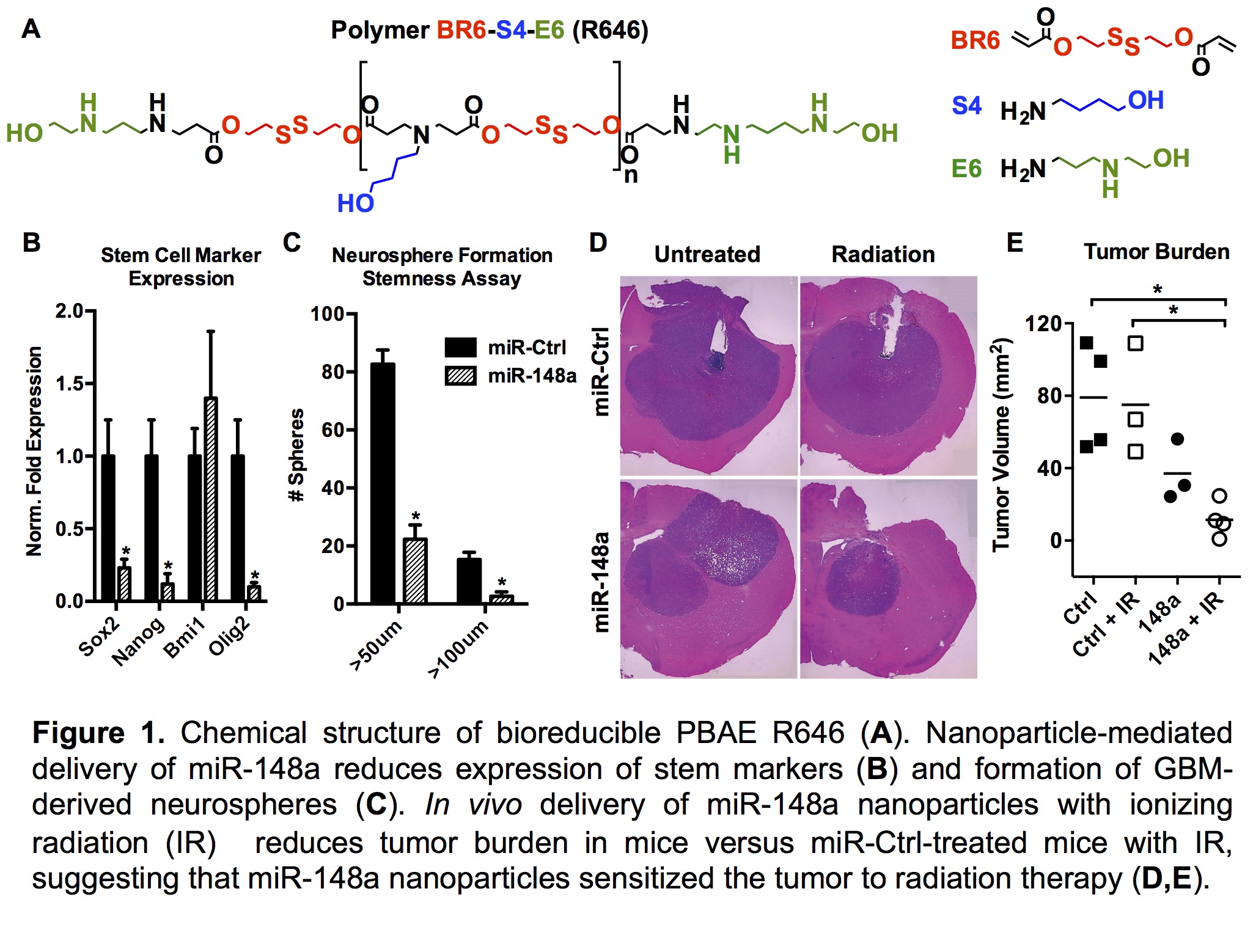Introduction: Glioblastoma (GBM) brain tumor patients have a median survival rate of only 14 months post-diagnosis. This has been attributed to stem-like cells found within brain tumors that resist treatment and propagate new tumors, which is due in part to the dysregulation of various micro RNAs (miRNAs). We will describe a novel polymeric nanoparticle system designed to deliver miRNA to brain tumor cells in vivo with the goal of reducing their stem-like characteristics and sensitizing them to radiation therapy. Specificially, we will use a novel, bioreducible poly(beta-amino ester) (PBAE) optimized to target miRNA to its site of action in the cytosol. We asked if PBAE nanoparticles can be used to deliver miRNA-148a (miR-148a), which has recently been shown to decrease the stem-like phenotype of GBM[1] and if nanoparticles carrying miR-148a reduce proliferation and stem cell marker expression in vitro. We also asked if PBAE nanoparticle delivery of miR-148a in vivo reduces tumor burden and sensitizes GBM to radiation therapy, raising the promise of translating the approach to treating GBM in vivo.
Methods: We synthesized bioreducible PBAEs by polymerizing a monomers shown in Figure 1A to form polymer BR6-S4-E6 (R646)[2]. In vitro inhibition of self-renewal capacity and stem cell marker expression were measured via neurosphere formation assays and qRT-PCR, respectively. Human GBM A172-iGSC cells, an induced GBM stem cell line[1], were injected into the striatum of nude athymic mice, allowed to form tumors, and nanoparticles carrying miR-Ctrl or miR-148a were administered intratumorally every 3-4 days for 4 weeks. Each miRNA group was also treated with or without 3 Gy ionizing radiation (IR) once weekly for 4 weeks, after which animals were sacrificed and tumor burden quantified.
Results and Discussion: We observed a significant reduction in neurosphere formation capacity and expression of stem cell markers in GBM1A neurospheres following miR-148a nanoparticle delivery (Fig. 1B, 1C). These results were replicated in an additional GBM neurosphere line, GBM1B (data not shown). In vivo delivery of miR-148a nanoparticles coupled with IR treatment significantly reduced tumor burden versus tumors treated with miR-Ctrl nanoparticles, both with and without IR. (Fig. 1D, 1E). Mice treated with miR-Ctrl and IR showed no significant change in tumor volume versus miR-Ctrl treated mice. (Fig. 1D, 1E).

Conclusions: We found that delivery of miR-148a using novel, bioreducible nanoparticles results in in vitro reductions in neurosphere proliferation and stem cell marker expression. In vivo delivery of miR-148a nanoparticles combined with radiation therapy reduces tumor burden, while radiation alone was ineffective, suggesting that nanoparticle-mediated delivery of miR-148a sensitized the brain tumor to radiation therapy. These results suggest that PBAE/miRNA nanoparticles have the potential to be a potent and combinatorial therapy for the treatment of brain cancer.
NIH1R01EB016721, R25CA15395, NIHR01073611, NIHF31CA196163
References:
[1] Lopez-Bertoni, H. et al. Oncogene 2014.
[2] Kozielski, K.L. et al. ACS Nano 2014.